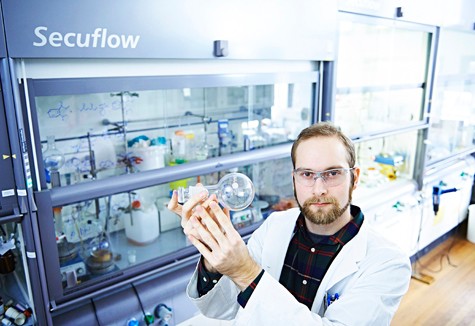Undergraduate Lights Up Solar Energy Research

By Lisa Jancarik
In the United States, solar energy accounts for more than one-third of new energy generating capacity. At the end of Q3 in 2014, more than half a million solar installations dotted American fields, rooftops and parking lots. This market is already large and growing, so there is a demand for better technology in storing solar energy.
During his baccalaureate training, University of Copenhagen graduate student Anders Bo Skov achieved an important breakthrough in storing solar energy. Remarkably, he was able to achieve the synthesis of his improved molecule in only four months. Along with his supervisor, Mogens Brondsted, he is publishing his findings in the journal, Chemistry – A European Journal.
Shape of Things to Come
Brondsted and his team have been examining the problem of absorbing and retaining solar energy, and then releasing it on demand. The difficulty lay in what seemed to be a natural law, which notes that the tendency of a molecule's ability to store energy decreases as its ability to absorb it improves, and vice versa.
The group has been working on the Dihydroazulene- Vinylheptafulvene (DHA-VHF) photochromic system, molecules that retain energy by changing their shape. That is, DHA changes its configuration to become VHF when it has captured energy. The VHF is the less stable form, so it seeks to release its energy eventually. The team had been able to make improvements to the molecule’s shape before Skov’s project, but each improved design showed less ability to retain the “energy storage” shape.
“Regardless of what we did to prevent it, the molecules would change their shape back and release the stored energy after just an hour or two. Anders’ achievement was that he managed to double the energy density in a molecule that can hold its shape for a hundred years,” explains Mogens Brondsted. He goes on to say that the problem now is how to release the energy once it’s stored. The molecule doesn’t like to switch back on demand.
The theoretical limit of the material’s ability to store energy – its energy density – is described in terms of the ability to boil water. In theory, one kilogram of perfectly designed molecules could bring three liters of water to a boil from room temperature, a megajoule of energy. One kilogram of the molecules Skov synthesized can bring 75 centiliters of water to boil in three minutes. The team is convinced that the energy storage capacity, corresponding to 25%, can be further optimized. For example, Skov points out that the team needs to examine the question of a better catalyst for the system’s reactions.
Skov’s molecules are nontoxic, a huge potential advantage over existing batteries. The DHA-VHF system releases no pollutants in the process of absorbing and releasing solar energy, not even carbon dioxide. Eventually, the material degrades into a harmless chemical found in chamomile flowers.